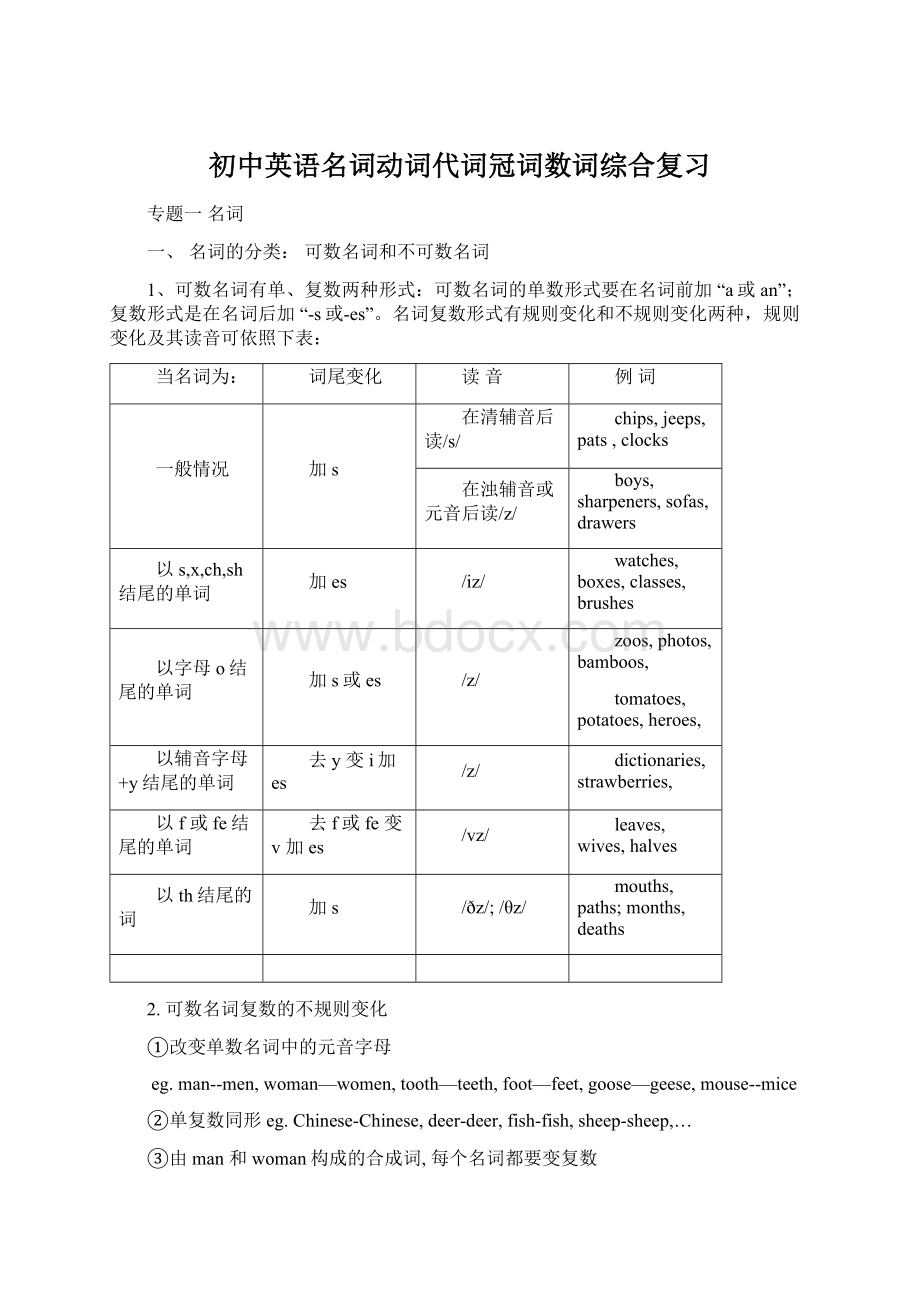初中英语名词动词代词冠词数词综合复习.docx
《初中英语名词动词代词冠词数词综合复习.docx》由会员分享,可在线阅读,更多相关《初中英语名词动词代词冠词数词综合复习.docx(21页珍藏版)》请在冰豆网上搜索。

初中英语名词动词代词冠词数词综合复习
专题一名词
一、名词的分类:
可数名词和不可数名词
1、可数名词有单、复数两种形式:
可数名词的单数形式要在名词前加“a或an”;复数形式是在名词后加“-s或-es”。
名词复数形式有规则变化和不规则变化两种,规则变化及其读音可依照下表:
当名词为:
词尾变化
读音
例词
一般情况
加s
在清辅音后读/s/
chips,jeeps,pats,clocks
在浊辅音或元音后读/z/
boys,sharpeners,sofas,drawers
以s,x,ch,sh结尾的单词
加es
/iz/
watches,boxes,classes,brushes
以字母o结尾的单词
加s或es
/z/
zoos,photos,bamboos,
tomatoes,potatoes,heroes,
以辅音字母+y结尾的单词
去y变i加es
/z/
dictionaries,strawberries,
以f或fe结尾的单词
去f或fe变v加es
/vz/
leaves,wives,halves
以th结尾的词
加s
/ðz/;/θz/
mouths,paths;months,deaths
2.可数名词复数的不规则变化
①改变单数名词中的元音字母
eg.man--men,woman—women,tooth—teeth,foot—feet,goose—geese,mouse--mice
②单复数同形eg.Chinese-Chinese,deer-deer,fish-fish,sheep-sheep,…
③由man和woman构成的合成词,每个名词都要变复数
eg.amandoctor—mendoctors,awomanteacher--womenteachers
注意:
有些名词表示一种物体具有不可分割的相同的两部分,在使用时只有复数形式
eg.trousers,clothes,glasses,shorts,scissors,etc;有些名词从形式上看是复数,
实际上是单数(其后的谓语动词要用单数).eg.maths,phyiscs,politics,news
3.不可数名词:
表示不能计算数目的人或物,称为不可数名词。
1).不能直接用数字表数量2).不能直接加a或an3).没有复数形式4).可用some、any、lotsof、plentyof、much修饰5).可用“量词短语”表示
不可数名词一般只有单数形式,但有其特殊用法:
(1)同一个词,变成复数形式,意义不同。
eg.food食物---foods各种食物,
time时间---times时代,green绿色---greens青菜
(2)有些不可数名词用复数代指具体的事物
eg.hope---hopes希望hardship---hardships艰苦
(3)物质名词在表示数量时,常用某个量词+of来表示
eg.acupoftea,sevenpiecesofbread,severalbagsofrice,…
(4)有些名词既可作可数名词也可作不可数名词,但词义有所不同。
例:
fruit水果——fruits表示不同种类的水果;food食物——foods各种食品;fish鱼——fishes鱼的种类;drink饮料、酒——adrink一杯/一份饮料、一杯酒;cloth布——,acloth桌布、抹布;sand沙——sands沙滩;tea茶——atea一杯茶;chicken鸡肉——achicken小鸡;orange橘汁——anorange橘子;glass玻璃——aglass玻璃杯,glasses眼镜;paper纸——apaper试卷、论文;wood木头——awood小森林;room空间、余地——aroom房间
三、名词的所有格
1.’s所有格。
1).用and连接两个并列的单数名词表示共有关系时,这时只在最后一个名词后加“’s.”
Thisis____________________(MaryandLily)bedroom.
2).1).用and连接两个并列的单数名词表示各有关系时,这时分别在每个名词后加“’s.”
Theseare________________(TomandJack)schoolbags.
3).以s结尾的名词,变所有格时在s后加“’”,不以s结尾的复数名词,仍加“’s”
Teachers’DayChildren’sDay
2.of所有格1).of用来表示无生命的名词所有格。
themapofChinathedooroftheroom
2).双重所有格:
of+名词所有格of+名词性的物住代词
Heisafriendofmy_________(brother).Issheadaughterof__________(you)?
巩固练习:
1.()1Shewasveryhappy.She inthemathstest.
A.makesafewmistakeB.madeafewmistakesC.madefewmistakesD.makesfewmistake
()2Weneedsomemore____.Canyougoandgetsome,please?
A.potatoB.potatosC.potatoesD.potatoe
()3_____are____forcuttingthings.
A.Knife/usedB.Knives/usedC.Knife/usingD.Knives/using
()4Whatbig____thetigerhas!
A.toothB.teethC.toothsD.toothes
()5Pleaseremembertogivethehorsesometree___.
A.leafsB.leavesC.leafD.leave
()6-Canwehavesome___?
-Yes,please.
A.bananaB.orangesC.appleD.pear
2.()1Theygotmuch___fromthosenewbooks.
A.ideasB.photosC.informationD.stories
()2Hegaveus____onhowtokeepfit.
A.someadvicesB.someadviceC.anadviceD.aadvice
()3Whenwesawhisface,weknew___wasbad.
A.somenewsB.anewsC.thenewsD.news
()4What___lovelyweatheritis!
A./B.theC.anD.a
3.()1-Wouldyoulike___tea?
-No,thanks.Ihavedrunktwo____.
A.any,bottlesoforangeB.some,bottlesoforange
C.many,bottlesoforangesD.few,bottleoforanges
()2Heishungry.Givehim___toeat.
A.twobreadsB.twopieceofbreadC.twopiecesofbreadD.twopiecesofbreads
()3Itreallytookhim:
___todrawthenicehorse.
A.sometimesB.hourC.longtimeD.sometime
()4Iwouldliketohave___.
A.twoglassesofmilkB.twoglassofmilkIC.twoglassesofmilksD.twoglassofmilks
()5Canyougiveme____?
A.ateaB.somecupofteaC.acupteaD.acupoftea
()6Pleasegiveme___paper.A.oneB.apieceC.aD.apieceof
()7Johnbought___forhimselfyesterday.
A.twopairsofshoesB.twopairofshoeC.twopairofshoesD.twopairsshoes
参考答案:
1.1-7CCBBBBC 2.1-4CBCA3.1-7BCDADDA
练习与巩固:
()1.Theygotmuch_____fromthosenewbooks.
A.ideasB.photosC.newsD.stories
()2.Ihavetwo_______andthreebottlesof_________here.
A.orange,orangeB.oranges,orangesC.oranges,orangeD.orange,oranges
()3.EveryeveningMr.Kingtakesa_________tohishome.
A.25minutes’walkB.25minute’swalkC.25minutewalkD.25minuteswalk
()4.Anold_______wantstoseeyou.
A.peopleB.personC.thepeopleD.theperson
()5.Helpyourselfto__________.
A.chickensandapplesB.chickensandappleC.chickenandappleD.chickenandapples
()6.Oh,dear.Iforgotthetwo_________.
A.room’snumberB.rooms’numberC.roomnumbersD.rooms’numbers
()7.ShehasbeeninTianjinfortenyears.Tianjinhasbecomehersecond_________.
A.familyB.houseC.homeD.room
专题二:
动词
动词是表示动作(study,find,swim等)或状态(be,like,feel等)的词。
动词具有人称、数量、时态、语态和语态变化。
动词分类:
动词有助动词、情态动词、联系动词和行为动词(实义动词)四类。
一)助动词
1、助动词be的用法如下:
1)构成各种进行时态。
如:
Itwasrainingalldayyesterday.昨天整天下雨。
2)构成被动语态。
如:
Themeetingwasheldyesterdayafternoon.会议是昨天下午举行的。
3)与不定式连用表示按照计划、预先安排或规定要发生的动作。
如:
TheyaretoseeanEnglishfilmthisevening.他们今天晚上看英语电影。
2、助动词do的用法如下:
1)构成疑问式或否定式。
如:
Doeshethinkso?
Ididn’tsayanythingabouttheresult.
2)在动词前加上do,does,did表示强调,意为“的确,确实”。
如:
Theydostudyhard.Shedoeslovehim.Hedidwanttohelptheoldman.
3)可以用作代动词,代替句子中已经出现的实义动词,以避免重复。
如:
—Whojumpshighestinyourclass?
—Jimdoes.(不说Jimjumps)
3、have:
助动词have的过去式是had。
have和had均可与动词过去分词一起构成完成时态。
如:
1)Hehaslivedhereforthreeyears.2)Assoonasthesunhadsettheyreturned.
4、shall,should:
助动词shall只用于第一人称的将来时态;助动词should是shall的过去式,构成过去将来时。
如:
1)Ishallsendtenletterstomygoodfriend.2)ShewantedtoknowifIshouldgotothepalace.
二)情态动词
情态动词本身有一定含义,但不能单独作谓语,要和行为动词一起构成谓语。
它们也能表明句子的否定、疑问或时态上的区别。
常见的情态动词有:
can,may,must,need,should等。
一.情态动词的用法
1.can用法
1)表示能力,与beableto同义,但can只用于现在时和过去时,beableto可用于各种时态。
Twoeyescanseemorethanone.注:
Canyou…?
Yes,Ican/No,Ican’t.
2).表示允许、请求
用could比can语气更加委婉客气,常用于couldI/you…..?
句型中,若表示同意时,用can回答而不用could.CouldIborrowthebook?
No,youcan’t.
3)。
表示推测“可能”常用于否定句或疑问句中。
(can’t表示一定不是)
Itcan’tbetrue.Canitbetrue?
2.may用法
1)表允许,请求=can
表示许可或征求对方的许可,常于第一人称连用。
注:
MayI….?
Yes,youmayNo,youcan’t/mustn’t.
在回答以may引起的问句时,多避免用这个词,而用其它方式,如Yes,please./Certainly.
2)表推测,可能、也许。
常用于肯定句中。
Maybeheknowsthenews.=He__________thenews.
3.must
1)表示义务。
意为“必须”(主观意志)。
Wemustdoeverythingstepbystep.
注:
MustI….?
Yes,youmust/No,youneedn’t(don’thaveto).
2)mustn’t表禁止、不允许。
Youmustn’ttalktoherlikethat.
3)表示揣测。
意为“想必、准是、一定”等,只用于肯定句。
否定、疑问句中must改为can.
Hemustbeill.Helookssopale.
She’swearingadiamondnecklace.Shemusthavealotofmoney.
注:
must表推测时,其反义疑问句与must后面的动词一致。
情态动词练习与巩固:
()1.MrWang______beinNanjingnow,hewenttoBeijingonlythismorning.
A.mustn’tB.maynotC.can’tD.needn’t
()2.–MustIsatyathome,Mum?
--No,you______.A.needn’tB.mustn’tC.don’tD.maynot
()3.–Canyougoswimmingwithusthisafternoon?
--Sorry,Ican’t.I_____takecareofmylittlesisterathomebecausemymotherisill.
A.canB.mayC.wouldD.haveto
()4.–MayIgotothecinema,Mum?
--Certainly.Butyou______bebackby11o’clock.
A.canB.mayC.mustD.need
()5.Tomakeourcitymorebeautiful,rubbish______intotheriver.
A.needn’tbethrownB.mustn’tbethrownC.can’tthrowD.maynotthrow
三)联系动词联系动词含有一定意义,它们要与其后做表语的形容词、名词或介词(短语)一起构成合成谓语。
系动词按意义可分为三类,而且有自己的特定用法。
1、按意义联系动词有:
be,appear,seem,keep,remain,continue,stay,prove等,如:
Jimappearsveryold.
2、表示感觉的联系动词有look,feel,smell,sound,taste等。
如:
Itsmellsbad.
3、表示转变的联系动词有become,fall,get,go,grow,turn等。
如:
Shebecomesmorebeautifulthanthreeyearsago.
Pizzaisready,andit______nice.A.smellsB.feelsC.goes
Thiskindofapple______delicious.Iwantonemore.A.smellsB.feelsC.tastes
Oh,themilk______strange,doyouthinkit’sOKtodrink?
A.istastedB.istastingCtastes
Thiskindofskirtlooks______andsells______.A.nice,wellB.nice,goodC.good,good
四)行为动词动词的时态动词的时态有很多。
初中阶段主要掌握:
一般现在时、一般过去时、现在进行时、过去进行时、一般将来时、现在完成时、过去完成时。
1.一般现在时1.表示现在的状态2.表示经常性或习惯性的动作3.表示客观事实或普遍真理。
Thesunrisesintheeastandsetsinthewest.太阳从东方升起,从西方落下。
例题解析:
1.---MayIhelpyou,sir?
---Yes,IboughttheTVthedaybeforeyesterday,butit______.
A.didn’tworkB.doesn’tworkC.won’tworkD.can’twork
2.______thebusuntilit______..
A.Getoff,stopsB.Getoff,willstopC.Don’tgetoff,stopsD.Don’tgetoff,willstop
3.The70-year-oldman____exercisesinthemorning.A.takesB.aretakingC.tookD.willtake
2.一般过去时1).概念:
过去某个时间里发生的动作或状态;过去习惯性、经常性的动作、行为。
2).基本结构:
①be动词;was/were…②行为动词:
动词的过去式
3).否定形式:
①was/were+not;②didn’t+动词原形
4)用动词的过去式。
作谓语的行为动词的词尾变化如下:
一般情况
+ed
以e字母结尾的辅音
+d
以辅音字母+y结尾
去y变i+ed
重读闭音节结尾的单词,末尾只有一个辅音字母
双写词尾字母+ed
3.现在进行时
1)现在进行时的构成:
主语+am/is/are+v-ing是现在进行时的构成形式v-ing现在分词的构成:
一般情况
+ing
以不发音字母e结尾的单词。
去e,加ing
+ing
以辅音字母+y结尾的单词
去e+ing
以重读闭音节结尾的单词,末尾只有一个辅音字母时.
双写词尾字母+ing
2)用法:
1.说话时正在进行或发生的动作(动作是在说话时正在进行)。
例如:
Sheishavingabathnow.
2.正在进行或发生的动作(但动作并不是必须在说话时正在进行)。
例如:
Youareworkinghardtoday.
1.Look!
Thepolice______(carry)thefoodontothebankoftheriver.
2.Listen!
Someone_____________(sing)intheroom.
3.It’ssixo’clock.TheGreens______________(eat)dinner.
4.过去进行时1).表示过去某一时刻或某一段时间正在进行的动作。
这一特定的过去时间,除有上,下文暗示以外,一般用时间状语来表示或由when/while引导的时间状语从句。
2).过去进行时(主句)when一般过去时(从句)。
3).一般过去时(主句)while过去进行时(从句)。
4).过去进行时(主句)while过去进行时(从句)。
(强调两个动作同时进行)
1.Didyouseehimcomein?
No,I__________(watch)afootballgame.
2.Mysister___